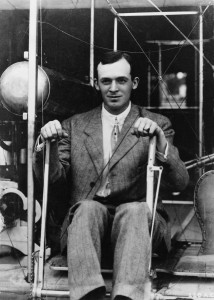Monday was the anniversary of our Declaration of Independence and today is the 99th anniversary of rated Army pilots. This day in 1912, Lieutenants Thomas D. Milling and Henry H. Arnold became the first and second United States military aviators respectively recognized as Army pilots.
Milling was a member of the 15th Calvary while Arnold was serving as an infantry officer in the Philippines. During his duty assignment in the islands, Arnold worked under command of Captain Arthur S. Cowan, of the Signal Corps. It was through Captain Cowan that Arnold received his chance to enter aviation training.
By way of Special Order 95, Arnold and LT Milling traveled to Dayton, OH for aviation training with the Wright Brothers aviation school at Simms Station. They began their flight training in early May 1911.
Their first instructors were Arthur L. Welsh and Cliff Turpin. Later Orville Wright also would fly with them. Both Milling and Arnold soloed in very short times; Milling right at two hours and Arnold logged a total of three hours and 48 minutes.
Remaining at the school to gain more experience, the two young army aviators eventually found themselves posted to College Park, MD. Their orders were to the Aeronautical Division, US Signal Corps and their duties included training Captain Charles D. Chandler and his adjutant, 1LT Roy Kirtland. Chandler had experience only in observation balloons up to this point and now required instruction in how to fly the Wright aircraft.
Following the completion of Chandler and Kirtland’s training, Milling and Arnold would go on to establish the Army’s first flight school. Their first class consisted of 14 aviators and over the course the coming months, three of the students would request transfer from aviation duties. These transfers, and indeed Arnold’s temporary absence from flying duties, came because of the extreme danger in aviation.
Crashes occurred on an almost weekly basis resulting in the injury or death of aviators throughout the nation. In the early days, everyone knew the business of flying airplanes was very dangerous. Still, the early aviators, both civilian and military, persevered in the fledgling industry.
Both Milling and Arnold would achieve general rank in the Army and later, when the Army Air Corps became a separate branch, the Air Force. During World War II, Arnold served as the Commanding General of the US Army Air Forces.
He would also become the only Air Force general to hold the rank of a five-star general.
-30-
©2011 J. Clark
Note: please go to my blog to view vids and photos


I’m a writing looking for information about Frederick L. Martin, leader of the 1924 Round the World flight, particularly about his aviation training and any interaction he may have had with Purdue classmate Cliff Turpin. Info and photos welcome. Do you have any.
Ann Allen
annallen@rtcol.com
Ann, no I do not. When I start one of my aviation blogs, I rely on the research I am able to do through the Embry-Aeronautical University Library, the Internet, and other sources. I will take a look in the library for you and if I come across something of interest, will pass it on.
jC